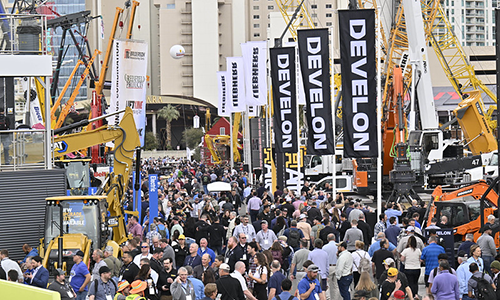While the global economy remains firmly on track to expand in 2022, a number of challenges are poised to serve as obstacles for the agriculture and construction equipment industries in the weeks and months ahead.
According to the latest business intelligence data from AEM, the global economy expanded by a robust 5.1% in 2021. And while projected growth of about 3.9% is expected for 2022, slower growth seems like a foregone conclusion. Short-term factors like the lingering COVID-19 pandemic, ongoing supply chain issues and persistent labor shortages, as well as long term factors like deglobalization and inflation, have emerged to dampen enthusiasm a bit on the heels of what has been a strong economic resurgence worldwide.
“The last recession we experienced ended the longest period of economic expansion in the United States, and that recession lasted from February 2020 to April 2020,” said AEM Director of Market Intelligence Benjamin Duyck. “Two months, in traditional economic terms, can’t even be accurately described as a recession. However, this economic disruption has impacted us all greatly, and we are still dealing with the aftereffects today – labor shortages, supply chain problems and higher interest rates.”
AEM offers a variety of business intelligence products designed to provide key industry insights, macroeconomic trends and industry data for a distinct competitive advantage. Learn more.
Continued Growth on the Horizon
The question of when the next economic recession will hit is one that’s easily asked, but not so easily answered. Recent volatility in the stock market has done little to quell concerns. However, the stock market is still up 20% when compared to a year ago, and 30% from two years ago (just prior to the onset of the COVID-19 pandemic).
“Can we accurately predict the next recession?” asked Duyck. “No, and it’s a common joke that economists correctly predicted 15 of the last 10 recessions. In other words, they are frequently wrong and pessimistic. Though, it will be interesting to see what happens, especially with high inflation.”
AEM has surveyed its members quarterly for nearly two years regarding how quickly they expect to recover to pre-COVID-19 levels. For some time, the responses had been generally quite positive, according to Duyck.
“But the data for this last quarter is moving again in the other direction, largely due to the headwinds we’re facing with inflation, workforce issues and supply chain disruptions,” he said.
Mitigating Factors
When it comes to ag equipment, the impact of inflation can’t be understated. There has been an 11.7% year-over-year increase in the prices of farm machinery. On the construction side, inflation is a little lower, but it has been rising gradually, with a 9.7% increase in the last quarter.
Talent acquisition is also a significant – and troublesome – factor for ag and construction equipment manufacturers. According to the results of AEM’s most recent quarterly member survey, hiring on the manufacturing floor remains a major issue – 84% of all respondents have experienced issues in this particular area, while 90% of all ag members surveyed have dealt with this particular issue.
Respondents offered a wide range of potential strategies and tactics for addressing hiring challenges – internships, educational partnerships, higher wages, bonuses, marketing and recruitment efforts, flexible hours, and outsourcing, are among the most common – but it’s clear workforce will remain a prevalent issue for equipment manufacturers for the foreseeable future.
What’s also just as clear are the factors that have led to the supply chain problems currently plaguing ag and construction equipment manufacturers, according to Duyck.
“Ultimately, the imbalance between supply and demand and COVID-19 restrictions eliminated all the inventory and the grease that allows the global supply clock to operate. Another metaphor that maybe hits closer to our industries is this: We’re running a machine that’s low on oil, and almost out of it. The machine will continue to run, and maybe even run for a while – until it doesn’t.” -- Benjamin Duyck, AEM Director of Market Intelligence
“COVID-19, followed by growing numbers of employees leaving the workforce, have led to both shutdowns and scarcity of products,” he added.
As a result, and in response, the supply chain has intended to initially adjust production lower, expecting lower demand. In addition, shipping companies cut schedules, expecting a drop in demand for shipments. And while demand in some aspects of the economy dropped, the decrease was not evenly spread over all industries and all workers.
While people still continued to spend money on homes and consumer purchases, interest rates remained low, and the U.S. experienced an expansion in monetary supply. Furthermore, workers and businesses were supported by the government. All of this, combined with the scarcity of products and higher demand results in inflation, adversely impacting supply chains.
Eventually, scarcity of products and higher demand resulted in inflation making its way up the supply chain – and factories could not expand easily due to bottlenecks in the chain caused by both low production and the global nature of production. Now, due to overdemand, it’s very difficult for suppliers to understand the true demand for their products.
“We can see this in our industries, not only from the OEMs and from the component manufacturers, but also from the end users of the OEMS,” said Duyck. “That, in short, is why we have supply chain issues. Workforce, supply chain, and all of it ties together and the results of policies and actions decades in the works set off by COVID-19.”
AEM Member Perspectives
According to AEM’s most recent quarterly survey of its members, more than 95% of ag and construction equipment manufacturers that responded said they are experiencing supply chain issues. However, it appears either demand is beginning to normalize, or supply chain signaling is improving, because 44% of respondents noted the issues are beginning to turn around.
“For the vast majority of these people, issues are both domestic and global,” said Duyck. “The issues are also widespread, but consensus opinion among members is that the issues lie particularly with prices, shipping and quantities of raw materials and, subsequently, inputs and components. In addition, the issues do not necessarily lie at the endpoint or receiving shipping, but rather at the supplier source – and especially international shipping.”
Many AEM member respondents indicated supply chain issues have caused them to fall behind, despite ongoing growth, which could eventually lead to changes in inventory management. According to Duyck, the third quarter of 2021 saw inventory levels increase between 15 and 20% in both the ag and construction segments, with ag seeing an additional 15% jump in the fourth quarter of last year.
“Whether changes in inventory management will actually take place has yet to be seen, but it’s quite possible that higher inventory levels will become more prevalent for some time,” said Duyck.
However, despite all the challenges impacting the ag and construction equipment industries, growth is still expected (albeit at a slower rate than in recent months).
Ag and Construction Equipment Market Outlooks
For the construction equipment market:
- Construction industry value is expected to grow 4.5% this year, largely driven by residential.
- AEM member perceptions show strong demand (83% see year-over-year growth ahead), and it’s reasonable to expect growth of 6-10% over the next 12 months on the heels of 6-10% stronger growth than was expected in 2021.
- Infrastructure spending is set to gain significant momentum in the coming years.
- Uncertainty related to the COVID-19 pandemic, high material costs and monetary policy all remain concerns.
For the ag equipment market:
- Farm income has increased regardless of government support declines and production cost increases.
- Member expectations remain strong (81% see year-over-year growth ahead, and 91% expect growth to continue).
- Inventories are too long after being depleted in 2021.
“Ultimately, the imbalance between supply and demand and COVID-19 restrictions eliminated all the inventory and the grease that allows the global supply clock to operate,” said Duyck. “Another metaphor that maybe hits closer to our industries is this: We’re running a machine that’s low on oil, and almost out of it. The machine will continue to run, and maybe even run for a while – until it doesn’t.”
AEM Business Intelligence
AEM is committed to helping ensure its members remain competitive in today’s ever-evolving global marketplace. In providing member insights, macroeconomic econometric data and much, much more, the association works to provide information that helps equipment manufacturers facilitate decision-making, understand competitors – and most importantly – grow in their ability to better serve their customers. To learn more, visit https://www.aem.org/business-intelligence.
Subscribe to the AEM Industry Advisor for more news and information relevant to equipment manufacturers.





